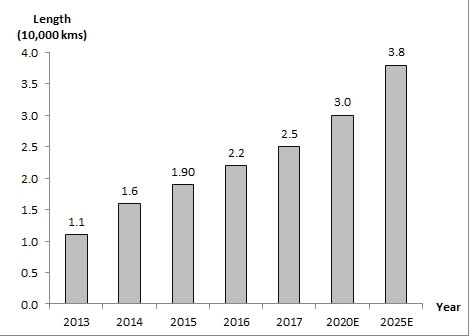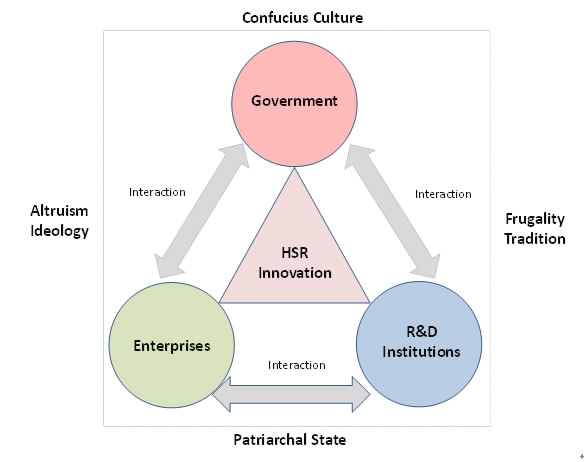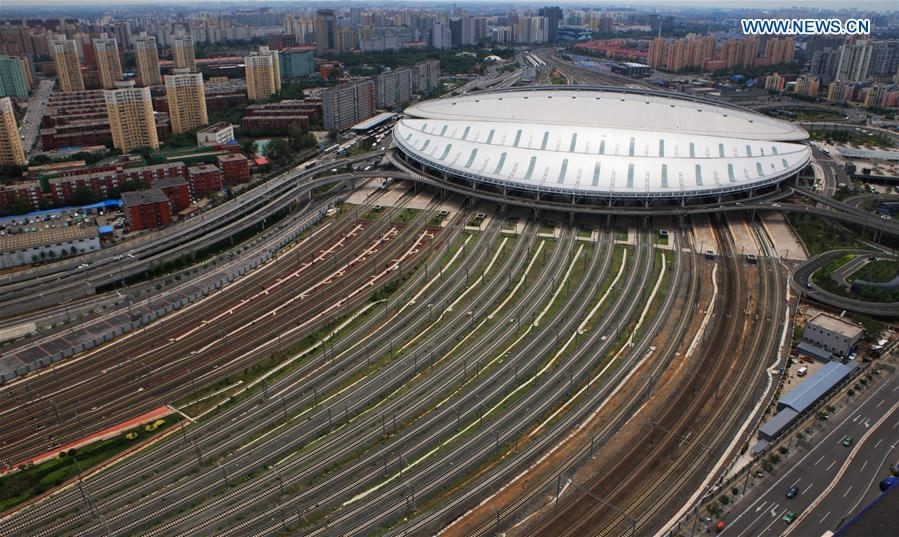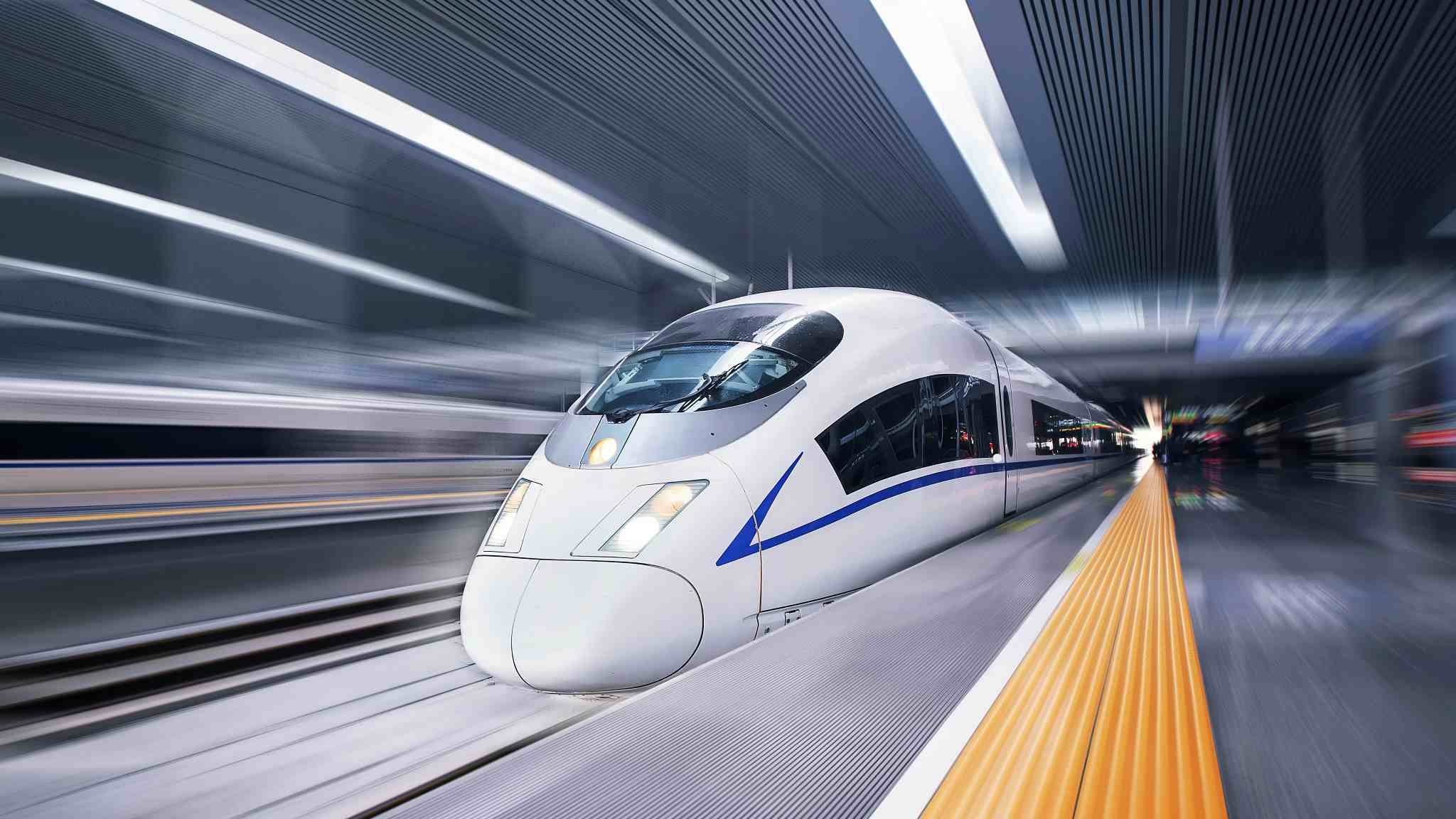In 2008, the first high-speed rail (HSR) line, from Beijing to Tianjin, the coastal municipality, directly under the Chinese central government with a total distance of approximately 120 kilometers, opened to accommodate electric multiple units (EMU) trains running at a maximum speed of 350 km/h and shorten the travel time to under less than 30 minutes which indicated to the whole world that China started to enter a high-speed era with China speed and the China Model of innovation and development. After near ten years continuous rapid development, by the end of 2017, the total railway length in operation reached 127,000 kilometers, of which there is around 25,000 kilometers high-speed rail network (see table 1), which is 66.3 percent proportional to the overall high-speed rail network worldwide.
Experts and government officials observed and are paying close attention to the China Model of
developing high-speed rail and looking for the rationale behind. Scholar Joshua Cooper Ramo even coded Beijing Consensus addressing government initiatives and legitimizing the notion of particularity as an alternative for Washington Consensus of market-friendly policies and reforms advocated by IMF and the World Bank.
So, the core question proposed at this moment is that what are the characteristics of China Model of developing high-speed rail, and what are the possible universal theoretical and practical implications for the other countries, especially the developing ones?

Table 1 High Speed Rail Length in Operation in China /Source: Compiled by the authors.
Table 1 High Speed Rail Length in Operation in China /Source: Compiled by the authors.
Triplex Interaction Framework: A explanatory theory framework of HSR innovation
There are pros and cons as to the innovative path of high-speed rail and dramatic technological and institutional innovation similar to the arguments as to whether China’s economy can be sustainable in the future, even after 30 years of fast economic growth since China adopted reform and opening-up policies around the 1980s. Today, China gradually mastered the core technologies of network control system and IGBT chip.
The railway industry not only established a high-speed rail technological system covering areas of project construction, EMUs, automated train control, hauling and electricity supply, operation management and risk management, to name a few but also pushes forward the China high-speed rail standard. The main reason behind the achievements lies in the triplex interaction among government bodies, market enterprises and R&D institutions. Of course, Chinese Confucius culture also serves as the catalyst to provide motivation for the stakeholders involved in the innovation process (see figure 1).

Figure 1 Triplex Interaction Framework
Figure 1 Triplex Interaction Framework
In figure 1, it’s clear that the government, enterprises and R&D institutions form positive interaction or good feedback loop supporting the strengthening of HSR innovations which also benefit greatly from Chinese culture heritages mainly comprising Confucius culture, patriarchal state, altruism ideology and frugality tradition.
Under this theoretical framework, the visible hand of the government shakes hand with the invisible hand of the market through the combination of government compensating for the market failure while enterprises and R&D institutions driven by market incentives for profit maximization.
Government: The mega-governance player for HSR innovation
There is no doubt that fast economic growth, blowout of people’s purchasing power, political influences exerted by varied interest groups contribute to the demand for HSR innovations and the industrial accumulation before and after the planned economy cultivated a solid technology foundation for railway development.
However, the advantage of China’s social system gives the government a prominent position as the mega-governance in the triplex framework mentioned above.
Firstly,
HSR innovation has positive externality and spillover effects benefiting the whole society which can only be supplied by government under the condition that the market mechanism is still in the process of development and cannot significantly lower the market risk and innovation cost for HSR. For example, Ministry of Railway (MOR) took a large piece of innovation cost and risk in developing new HSR technologies.

An overview of Beijing South Railway Station, northern terminal of the Beijing-Shanghai high-speed railway in Beijing, capital of China, June 24, 2011. /Xinhua Photo
An overview of Beijing South Railway Station, northern terminal of the Beijing-Shanghai high-speed railway in Beijing, capital of China, June 24, 2011. /Xinhua Photo
Secondly, HSR innovation calls for the devotion of resources of fundamental science and technology researchers and new developments which are generally is carried out by universities, research institutions and laboratories. The Chinese governments set up and injected a tremendous amount of R&D fund to support HSR innovations. For example, there are at least two national key HSR research centers in Beijing Jiaotong University and Xinan Jiaotong University.
Finally, enterprises are reluctant to invest in physical and human capital specialty assets unless the uncertainty of market demand and challenges can be greatly eased. The historical experience shows that Ministry of Railway or the present China Railway Corporation’s (CRC) technical standard and procurement plan implicitly endorsed the R&D investment by enterprises. For example, MOR or CRC placed 300 high-speed trainset orders with China Rolling Stock Company (CRSC) in 2017 and worked out the five-year plan of rolling stock equipment which boosted the confidence of CRSC to invest heavily in the expansion of production scale and R&D intensity.
The data shows that HSR innovation capacity increased rapidly from 2008 to 2011 and gained momentum after 2013 thanks to the institutional advantage in China’s circumstance. With the stabilization and expansion of HSR market at home and abroad, it’s expected that market system will play an even more important role in the future.
This commentary is supported by China Social Science Foundation Major Projects “Research on High-speed Rail Theoretical Framework and Evolutionary Path” ( Project Number: 17ZDA084)
(Li Hongchang is Associate Professor of Beijing Jiaotong University. Lin Xiaoyan is a professor at Beijing Jiaotong University. The article reflects the authors' opinion, and not necessarily the views of CGTN.)





